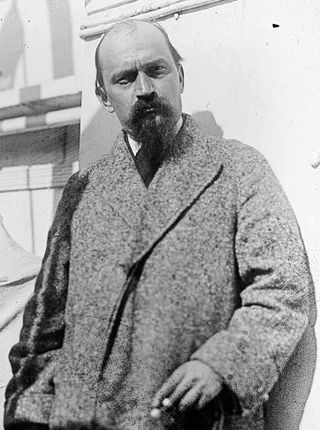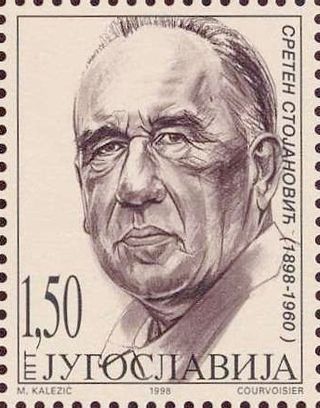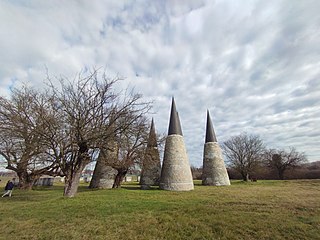
Josip Broz, commonly known as Tito, was a Yugoslav communist revolutionary and politician who served in various positions of national leadership from 1943 until his death in 1980. During World War II, he was the leader of the Yugoslav Partisans, often regarded as the most effective resistance movement in German-occupied Europe. He also served as prime minister from 2 November 1944 to 29 June 1963 and president of the Socialist Federal Republic of Yugoslavia from 14 January 1953 until his death. His political ideology and policies are collectively known as Titoism.

Ivan Meštrović was a Croatian and Yugoslav sculptor, architect, and writer. He was the most prominent modern Croatian sculptor and a leading artistic personality in contemporary Zagreb. He studied at Pavle Bilinić's Stone Workshop in Split and at the Academy of Fine Arts Vienna, where he was formed under the influence of the Secession. He traveled throughout Europe and studied the works of ancient and Renaissance masters, especially Michelangelo, and French sculptors Auguste Rodin, Antoine Bourdelle and Aristide Maillol. He was the initiator of the national-romantic group Medulić. During the First World War, he lived in emigration. After the war, he returned to Croatia and began a long and fruitful period of sculpture and pedagogical work. In 1942 he emigrated to Italy, in 1943 to Switzerland and in 1947 to the United States. He was a professor of sculpture at the Syracuse University and from 1955 at the University of Notre Dame in South Bend, Indiana.

The Croatian Spring, or Maspok, was a political conflict that took place from 1967 to 1971 in the Socialist Republic of Croatia, at the time part of the Socialist Federal Republic of Yugoslavia. As one of six republics comprising Yugoslavia at the time, Croatia was ruled by the League of Communists of Croatia (SKH), nominally independent from the League of Communists of Yugoslavia (SKJ), led by President Josip Broz Tito. The 1960s in Yugoslavia were marked by a series of reforms aimed at improving the economic situation in the country and increasingly politicised efforts by the leadership of the republics to protect the economic interests of their respective republics. As part of this, political conflict occurred in Croatia when reformers within the SKH, generally aligned with the Croatian cultural society Matica hrvatska, came into conflict with conservatives.

The Socialist Federal Republic of Yugoslavia (SFRY), commonly referred to as SFR Yugoslavia or Socialist Yugoslavia or simply as Yugoslavia, was a country in Central and Southeast Europe. It emerged in 1945, following World War II, and lasted until 1992, with the breakup of Yugoslavia occurring as a consequence of the Yugoslav Wars. Spanning an area of 255,804 square kilometres (98,766 sq mi) in the Balkans, Yugoslavia was bordered by the Adriatic Sea and Italy to the west, by Austria and Hungary to the north, by Bulgaria and Romania to the east, and by Albania and Greece to the south. It was a one-party socialist state and federation governed by the League of Communists of Yugoslavia, and had six constituent republics: Bosnia and Herzegovina, Croatia, Macedonia, Montenegro, Serbia, and Slovenia. Within Serbia was the Yugoslav capital city of Belgrade as well as two autonomous Yugoslav provinces: Kosovo and Vojvodina.

The Yugoslav Partisans, or the National Liberation Army, officially the National Liberation Army and Partisan Detachments of Yugoslavia, was the communist-led anti-fascist resistance to the Axis powers in occupied Yugoslavia during World War II. Led by Josip Broz Tito, the Partisans are considered to be Europe's most effective anti-Axis resistance movement during World War II.

Sreten Stojanović was a Serbian sculptor and art critic. His artistic individuality was best observed in portraits made of various materials.

Antun Augustinčić was a Croatian sculptor active in Yugoslavia and the United States. Along with Ivan Meštrović and Frano Kršinić, he is considered one of the three most important Croatian sculptors of the 20th century. His most notable sculptures include the Peace monument which stands in front of the United Nations building in New York City, the Miner statue in front of the International Labour Organization headquarters in Geneva, and the sculpture of Yugoslav president Josip Broz Tito, present in several copies throughout former Yugoslavia.

World War II in the Kingdom of Yugoslavia began on 6 April 1941, when the country was invaded and swiftly conquered by Axis forces and partitioned among Germany, Italy, Hungary, Bulgaria and their client regimes. Shortly after Germany attacked the USSR on 22 June 1941, the communist-led republican Yugoslav Partisans, on orders from Moscow, launched a guerrilla liberation war fighting against the Axis forces and their locally established puppet regimes, including the Axis-allied Independent State of Croatia (NDH) and the Government of National Salvation in the German-occupied territory of Serbia. This was dubbed the National Liberation War and Socialist Revolution in post-war Yugoslav communist historiography. Simultaneously, a multi-side civil war was waged between the Yugoslav communist Partisans, the Serbian royalist Chetniks, the Axis-allied Croatian Ustaše and Home Guard, Serbian Volunteer Corps and State Guard, Slovene Home Guard, as well as Nazi-allied Russian Protective Corps troops.
Bogdan Bogdanović was a Serbian and Yugoslav architect, urbanist and essayist. He taught architecture at the University of Belgrade Faculty of Architecture, where he also served as dean. Bogdanović wrote numerous articles about urbanism, especially about its mythic and symbolic aspects, some of which appeared in international journals such as El País, Die Zeit, and others. He was also involved in politics, as a Yugoslav Partisan in World War II, later as mayor of Belgrade. When Slobodan Milošević rose to power and nationalism gained ground in Yugoslavia, Bogdanović became a dissident.

The authorities of the Socialist Federal Republic of Yugoslavia established many World War II memorials during its existence. Several memorial sites were established between 1945 and 1960, though widespread building started after the founding of the Non-Aligned Movement.

Monument to the revolutionary victory of the people of Slavonia or Monument to the people-hero of Slavonia was a World War II memorial sculpture by Vojin Bakić, that was located in, now uninhabited, Serbian village of Kamenska, Brestovac, Slavonia, Croatia. It was destroyed by the Armed Forces of Croatia in 1992.

The Monument to the Uprising of the People of Kordun and Banija is a World War II monument built on Veliki Petrovac, the highest peak of Petrova Gora (English: Peter's Mountain), a mountain range in central Croatia. The site of the monument is shared between three municipalities: Gvozd and Topusko, in Sisak-Moslavina County and Vojnić, in Karlovac County.

Miodrag Živković was a Serbian sculptor and university professor. He is well-known for his work on memorial complexes throughout Yugoslavia.

When World War II started, Zagreb was the capital of the newly formed autonomous Banovina of Croatia within the Kingdom of Yugoslavia, which remained neutral in the first years of the war. After the Invasion of Yugoslavia by Germany and Italy on 6 April 1941, German troops entered Zagreb on 10 April. On the same day, Slavko Kvaternik, a prominent member of the Ustaše movement, proclaimed the creation of the Independent State of Croatia (NDH), an Axis puppet state, with Zagreb as its capital. Ante Pavelić was proclaimed Poglavnik of the NDH and Zagreb became the center of the Main Ustaša Headquarters, the Government of the NDH, and other political and military institutions, as well as the police and intelligence services.

Dudik Memorial Park is a World War II war memorial park located in Vukovar in eastern Croatia. The site is dedicated to 455 individuals who were executed by the authorities of the Independent State of Croatia during the World War II in Yugoslavia.

Israel–Yugoslavia relations were historical foreign relations between Israel and now split-up Socialist Federal Republic of Yugoslavia. Positive initial relations between the two states were subsequently negatively affected by the Arab–Israeli conflict and close relations between Yugoslavia and some Arab states, particularly Yugoslav relations with Egypt. Despite cancelation of the formal relations after the Six-Day War informal, commercial and cultural exchanges continued throughout the Cold War period.
































































































































